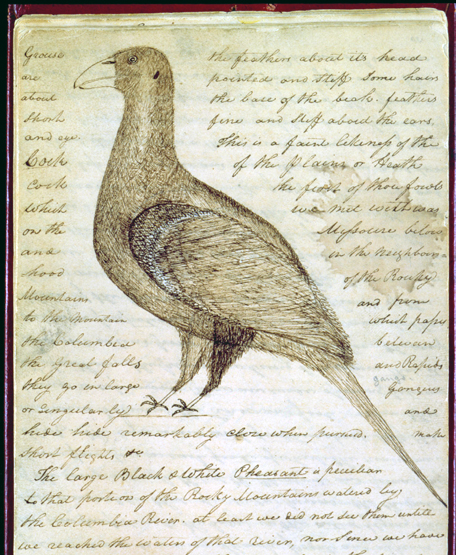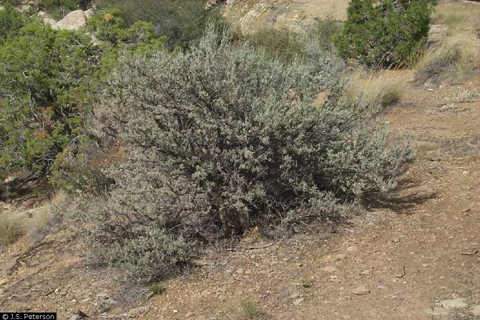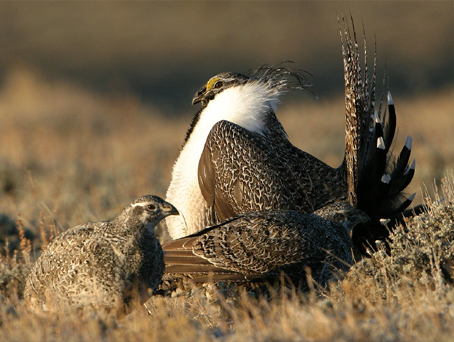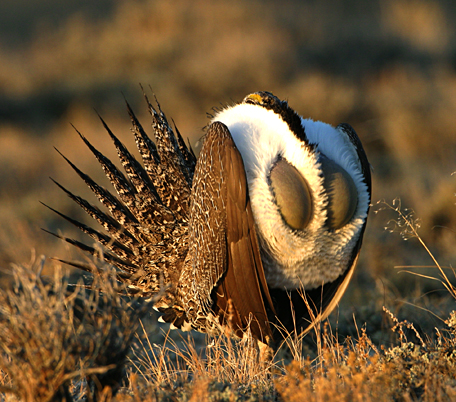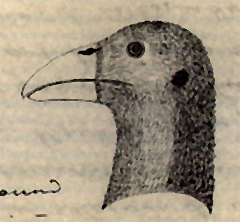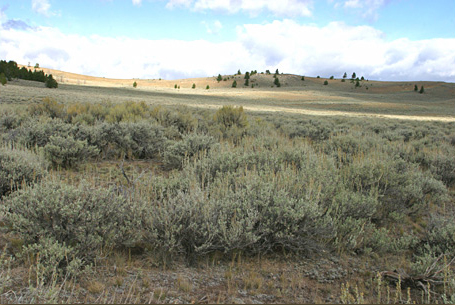Figure 1
Sage Grouse, Centrocercus urophasianus[1]Centrocercus urophasianus is pronounced sen-tro-SER-kus YOU-row-faze-ee-AY-nus. The name of the genus is a combination of the Greek kentron, meaning point, and kerkos, tail. The specific epithet is … Continue reading
“Cock of the Plains”
Drawing by William Clark, 2 March 1806. Missouri Historical Society, Voorhis Collection, No. 2.
Meriwether Lewis first observed sage grouse at the mouth of the Marias River on 6 June 1805. Private John Shields was sent to kill one, but he missed his shot. They expected to see more of them, however, for “the Indians informed us they were common to the Rocky Mountains.” The bird was new to science then, and plentiful throughout the western part of what is now the United States.
Since then the species has declined to the point that it may soon be listed by the U.S. Fish and Wildlife Service as Threatened, under the Endangered Species Act of 1973. Modern interpretations of the expedition’s sage grouse field notes provide insights into the bird’s vulnerability to changing habitats, and give clues to current management requirements necessary to arrest its decline.
The journals record sage grouse encounters from the mouth of the Marias River, up the Missouri to Camp Fortunate, along the trail to Lemhi Pass, along the Salmon River, down the Clearwater River, then to the confluence of the Walla Walla River with the Columbia. Lewis and Clark documented sage grouse abundance and distribution: “The Heath Cock or cock of the Plains is found in the Plains of Columbia and are in great abundance from the enterance of Lewis’s river to the mountains which pass the Columbia between the Great falls and Rapids of that river.” Thus we have a historic account of sage grouse range and abundance, both substantially diminished today. At the confluence of the Snake and Columbia Rivers on 17 October 1805, Clark killed “a Fowl of the Pheasent kind as large as a turkey. The length from his beeck to the end of its tail 2 feet 6-3/4 Inches, from the extremity of its wings across 3 feet and 6 Inches. the tail feathers 13 Inches long, feeds on grass hoppers, and the seed of wild Isoop,” which is now called sagebrush.[2]“Issop”—by which Clark meant hyssop (HISS-up)—is the Biblical name for an aromatic plant used in Hebrew rites of purification; today it refers to a woody Eurasian plant (Hyssopus … Continue reading
Sagebrush: Shelter and Food
Of the twelve species of the genus Artemisia listed in the USDA PLANTS Database, nine are still found in states through which the Lewis and Clark Trail passes. The abbreviation Nutt. following the name stands for Thomas Nuttall, the botanist who first described the big sagebrush, and gave it is scientific name. The genus, pronounced ar-te MEE-zee-uh, is named after Artemis, the Ancient Greek goddess of wilderness; the species, pronounced try-den-TAH-tah, refers to its three-lobed gray-green leaves.
Sagebrush is the critical component of sage grouse diet, and the distribution of sage grouse and big sagebrush overlap. Another important observation was that sage grouse are large birds. Large animals tend to be long-lived, with relatively low reproductive rates, and this is the case with sage grouse. This life style makes such animals especially vulnerable to predation.
Clark recorded the behavior sage grouse use to avoid predators—”they go in large gangues or Singularly and hide remarkably close when pursued, make short flights, &c.”— along with their coloration: “The colour is an uniform mixture of dark brown reather bordering on a dove colour, redish and yellowish brown with some small black specks. in this mixture the dark brown prevails and has a slight cast of the dove colour at a little distance.” In other words, sage grouse avoid predators through camouflage, singular dispersal and remaining hidden until the last moment of discovery, when they startle their attackers.
Clark’s sage grouse description included an important anatomical feature: “the gizzard of it is large and much less compressed and muscular than in most fowls; in short it resembles a maw (stomach) quite as much as a gizzard.” The gizzard functions to grind food before it enters the stomach. Most birds ingest small stones that are used in the gizzard to facilitate grinding hard foods such as seeds. The sage grouse evolved certain characteristics in association with its habitat, including a diet that consists largely of sagebrush, which, in turn, favored the evolution of a gizzard that is uniquely nonmuscular for a grouse.
Sage grouse have been described as a landscape species. That is, they use small areas of different habitat types for varying periods, and their presence may be used as an indication of the health of a landscape.
Characteristics
The word lek is from the Swedish verb leka, meaning to play. In ornithology it denotes an area consisting of a number of display territories, or “dancing grounds,” where male grouse carry out their courtship dances and mate with females generation after generation. With tail erect and fanned, and with rigid wings almost touching the ground, the cock inflates a sac in his throat until it hides his head, and the fleshy chambers of the sac protrude. By inhaling and exhaling rapidly the bird produces a resonant booming sound.
Sage grouse begin their life cycle by assembling on leks for mating. A lek is a bald area on ridges or similar openings in sagebrush country about the size of a football field where grouse assemble year after year between February and April. Here the males strut about, flaring their tail feathers to fan-shaped. Clark described: “the tail is composed of 19 feathers of which that in the center is the longest, and the remaining 9 on each side diminish by pairs as they receede from the center; that is any one feather is equal in length to one equa distant from the center of the tail on the opposite side. the tail when foalded comes to a very sharp point and appears long in proportion to the body.” The cock puffs up a large, whitish air sack on its chest, makes a soft drumming noise, and parades about tail feathers displayed and air sack puffed up, hoping for a hen to take notice. Unfortunately for most cocks only one or two cocks do most of the mating. Sage grouse return to the same leks each year. Some leks have been in annual use for hundreds of years. Hens build nests, lay eggs, and incubate them under cover of sagebrush. When we look across a sea of grey-colored sagebrush it may appear uniform and monotonous, but by walking through good stands we may recognize they are second only to riparian areas for species diversity. The hen depends on grass and forbs between sagebrush for additional cover and protection from predators such as coyotes, ravens, raptors, and magpies.
Chicks can walk as soon as they are hatched. The hen generally leads the newly hatched chicks to a riparian area near a river, stream, or pond. The chicks focus on the energy- and protein-rich beetles, ants, and other insects at first and grow rapidly, becoming able to fly short distances in two weeks. Later the chicks consume more forbs. Within five weeks they’re capable of sustained flight. The hens and cocks mostly eat sagebrush leaves. Later in the summer, when sagebrush zones dry out, sage grouse often move to moist meadows, riparian areas or higher elevations in habitats such as around aspen groves. In these areas the grouse may feed upon lupine, clover, dandelions, yarrow, and other soft-tissue foods. Sage grouse do not need free water if plant foods are succulent enough.
Lewis’s Description
Figure 5
“Cock of the Plains”
Drawing by Lewis, 2 March 1806
American Philosophical Society, Codex J, p. 107.
Meriwether Lewis described the sage grouse in detail at Fort Clatsop on 2 March 1806. Clark copied Lewis’s writing, as usual, and added a few observations of his own which are bracketed here. Differences in capitalization, as well as minor differences in spelling, are considered immaterial, as when Lewis drops one p from opposite while Clark adds the second p but drops the e. Otherwise, the comparisons illustrate a few of the small differences in judgment that could emerge between the two captains. Compare Lewis’s sketch of the head of a male (below) with that of Clark’s full image (fig. 1).
The [Heath Cock or] Cock of the Plains is found in the plains of Columbia and are in Great abundance from the entrance of the S. E. fork of the Columbia to that of Clark’s river [from the enterance of Lewis’s river to the mountains which pass the Columbia between the Great falls and Rapids of that river.].[3]Clark is referring to Celilo Falls and the Cascades of the Columbia, which are separated by the Cascade Range. this bird [fowl] is about 2/3rds [3/4ths] the size of a turkey. the beak is large short curved and convex. the upper exceeding the lower chap.[4]“Chap” is the wildlife biologist’s name for the beak of a bird. the nostrils are large and the back black. the colour is an uniform mixture of dark brown reather bordeing [bordering] on a dove colour, redish and yellowish brown with some small black specks. in this mixture the dark brown prevails [provails] and has a slight cast of the dove colour at a little distance. the wider side of the large [larger] feathers of the wings are of a dark brown only.
the tail is composed of 19 feathers of which that in the center is the longest, and the remaining 9 on each side deminish by pairs as they receede from the center; that is any one feather is equal in length to one of an equa distant [equal distance] from the Center of the tail on the opposite Side. the tail when foalded [folded] comes to a very sharp point and appears long in proportion [perpotion] to the body. in the act of flying the tail resembles that of a wild pigeon. tho’ the motion of the wings is much that of the pheasant and Grouse.
they have four toes on each foot of which the hinder one is short. the leg is covered with feathers about half the distance between the knee and foot. when the wings is expanded there are wide opening between it’s feathers, the plumage being so narrow that it dose [does] not extend from one quill to the other. the wings are also proportionably [propotionably] short, reather more so than those of the pheasant or grouse.the habits of this bird are [is] much the same as those of the [Prarie hen or] grouse. only that the food of this fowl is almost entirely that of the leaf and buds of the pulpy leafed thorn,[5]Lewis means the greasewood, Sarcobatus vermiculatus. A. Scott Earle and James L. Reveal, Lewis and Clark’s Green World: The Expedition and its Plants (Helena, Montana: Farcountry Press, 2003), … Continue reading nor do I ever recollect seeing this bird but in the neighbourhood of that shrub. they sometimes feed on the prickley pear [(this sentence omitted by Clark)]. the gizzard of it is large and much less compressed and muscular than in most fowls; in short it resembles a ma[6]Webster (1806): “the ventricle of the stomach, the craw.” quite as much as a gizzard. when they fly they make a cackling noise something like the dunghill fowl. the following is a likeness of the head and beak [omitted by Clark]. the flesh of [this fowl[7]The common chicken. the cock of the Plains is dark, and only tolerable in point of favor. I do not think it as good as either [with] the Pheasant [or Prarie hen,] or Grouse.— it is invariably found in the plains [omitted by Clark].— The feathers about it’s head are pointed and stif some hairs about the base of the beak. feathers short fine and stif about the ears, [and eye.] This is a faint likeness of the Cock of the plains or Heath Cock [compare Clark’s drawing] the first of those fowls which we met with was on the Missouri below and in the neighbourhood of the Rocky Mountains and from to the mountain which passes the Columbia between the Great Falls and Rapids they go in large gangues or Singularly and hide remarkably close when pursued, make short flights, &c.
Survival
Figure 6
A field of Sagebrush in the Beaverhead Valley
Big sagebrush, Artemesia Tridentata
© 2000 Steve Sherman, Lone Wolf Photography.
Sage grouse are entirely dependent on sagebrush during winter, when snow depths are generally shallower in sagebrush zones. The field pictured possibly consists of Artemisia tridentata, big sagebrush. However, the differences among many of the seventeen different species of the genus Artemisia in the U.S. are so difficult to distinguish that even experienced botanists are challenged.
Sage grouse still inhabit some parts of Lewis and Clark Trail states Montana, Idaho, and Oregon, as well as Wyoming and Nevada. It thrives in comparatively smaller areas in North and South Dakota and Washington, as well as Colorado, Utah, California, and western Canada. However, large areas of sage grouse habitat in all of those states have been impacted by explorations and extractions of oil and natural gas, and the prospect is for increasing pressure from those industries that could threaten the survival of the bird. Even wind energy development is problematic. Sage grouse, which nest on the ground, will not raise their young near aerial structures like wind turbines, which often provide temporary perches for eagles and other avian predators on the hunt.
Furthermore, their preferred habitats are being taken over by cheatgrass (Bromus tectorum L.), which fuels searing wildfires that destroy the native sagebrush that the grouse depend on for food, especially in winter.[8]Lewis and Clark would not have encountered cheatgrass anywhere in America because it was native to Europe and parts of Africa and Asia, and was accidentally introduced to the western hemisphere in … Continue reading
Since the early decades of the 20th century, overall sage grouse numbers have declined by 90 percent, partly as a consequence of a 50 percent shrinkage in their sagebrush habitat. Early in March 2010 the U.S. Interior Department rejected environmentalists’ demands that the sage grouse be listed as a threatened or endangered species, on the grounds that higher priorities precluded such an action. Meanwhile, oil, gas, and wind energy industries continue to support research on sage grouse in the hope of meliorating the problems caused by their extractive intrusions.
Commentary
We may now summarize Lewis and Clark’s observations, supplement them with a few modern interpretations, and come up with reasons for the decline of sage grouse as well as what might be done to reverse it. Five points stand out: 1) Being large birds, sage grouse are typically long-lived with comparatively low reproductive rates. This makes them especially vulnerable to predation. 2) Sage grouse evade predation by camouflage, and by remaining hidden under dense cover. 3) Because their diet is restricted to soft foods, they have evolved nonmuscular gizzards. 4) Sage grouse are solely and absolutely dependent on big sagebrush for food, as well as cover. 5) Sage grouse are very faithful to established lek locations. Sage grouse populations have declined as each of these components has been compromised.
Big sagebrush habitats have been eliminated on a broad scale. Most of the ancient stands in the Columbia river basin have been converted to wheat fields, which make fine food for pheasants,[9]The scientist’s name for the common pheasant is Phasianus (fayz-ee-AY-nus; see note 1, above) colchicus (COAL-chee-kus; from the ancient Greek province of Colchis, where the Phasis River … Continue reading but sage grouse cannot digest grains. In the inland west sagebrush has been destroyed by herbicides, or else burned to expand hay production or in the erroneous belief that it would improve grasses for cattle grazing. In some areas, the prevention of periodic natural fires has allowed invasions of trees such as junipers. The elimination of the big sagebrush habitat has been a major cause of sage grouse decline.
Sage grouse predators have become more successful. Construction of power lines and fences across sage grouse habitats has provided perches for avian predators to observe and capture sage grouse. The proliferation of red foxes and the introduction of domestic dogs have compounded the problem. Overgrazing has reduced the density of inter-shrub grasses and forbs, and sagebrush has deteriorated, all reducing cover and increasing sage grouse exposure to predation.
Sometimes historic leks have been deliberately but thoughtlessly destroyed. In one instance a lek was flooded to create a holding pond, and grouse were seen to be attempting mating dances on the ice above it—unsuccessfully. In another case grouse were observed attempting displays on a roadway covering a historic lek, causing some to be killed by traffic. Interference with mating behavior is a very effective way to induce population decline. Coalbed methane extraction in big sagebrush country may be the last nail in the sage grouse’s coffin. Even worse than the impacts of access roads and drilling pads is the need to pump water into a coalbed to force out the methane. The water table concentrates underground salt, which sterilizes the soil, killing all vegetation, including sagebrush. Finally, ponds of water create breeding grounds for mosquitoes, including some that carry west-Nile virus, which has been shown to be fatal to sage grouse.
We know what actions would reverse the decline of sage grouse in America. Hopefully, we will find the will and the means to apply them.
Notes
| ↑1 | Centrocercus urophasianus is pronounced sen-tro-SER-kus YOU-row-faze-ee-AY-nus. The name of the genus is a combination of the Greek kentron, meaning point, and kerkos, tail. The specific epithet is from another Greek word for tail, oura, plus phasianos, pheasant. The noun pheasant was originally applied to a bird that was native to the valley of the Phasis River (now the Rioni River), which drains into the Black Sea from the Repubic of Georgia. In the time of Lewis and Clark the word pheasant stood for “a genus of gallinaceous birds,” according to lexicographer Noah Webster (1806), and the explorers often used it in that sense. Gallinaceous then referred to “domestic fowls, or the gallinae”; the family Galliformes (Latin gallus, cock, and forma, shape) now includes pheasants, grouse, turkeys, quail, and all domestic chickens. Lewis and Clark are credited with the discovery of five gallinaceous birds in addition to the sage grouse: the Columbian sharp-tailed grouse, the dusky grouse, Franklin’s grouse, the Oregon ruffed grouse, and the mountain quail. The taxonomy of the sage grouse was written in 1827 by the biologist Charles Lucien Bonaparte (1803-1857), a nephew of Napoleon. Paul Russell Cutright, Lewis & Clark, Pioneering Naturalists (Lincoln: University of Nebraska Press, 1969), 157, 388; Raymond Burroughs, ed., The Natural History of the Lewis and Clark Expedition (paperback ed., with an introduction by Robert Carriker, East Lansing: Michigan State University Press, 1995), 211-15. |
|---|---|
| ↑2 | “Issop”—by which Clark meant hyssop (HISS-up)—is the Biblical name for an aromatic plant used in Hebrew rites of purification; today it refers to a woody Eurasian plant (Hyssopus officinalis) used in perfumes and as a condiment. In his Compendious Dictionary of the English Language (1806), Webster defined hyssop simply as “a genus of aromatic plants.” Lewis and others in the Corps used the word in describing sagebrush. In northeastern Montana on 12 May 1805, Lewis saw “the wild hysop sage.” Near the junction of the Lemhi and Salmon Rivers on 27 August 1805, Patrick Gass observed “a kind of wild sage or hyssop, as high as a man’s head.” Gass may have been referring to the plant now commonly called big sagebrush, Artemisia tridentata. |
| ↑3 | Clark is referring to Celilo Falls and the Cascades of the Columbia, which are separated by the Cascade Range. |
| ↑4 | “Chap” is the wildlife biologist’s name for the beak of a bird. |
| ↑5 | Lewis means the greasewood, Sarcobatus vermiculatus. A. Scott Earle and James L. Reveal, Lewis and Clark’s Green World: The Expedition and its Plants (Helena, Montana: Farcountry Press, 2003), 205. |
| ↑6 | Webster (1806): “the ventricle of the stomach, the craw.” |
| ↑7 | The common chicken. |
| ↑8 | Lewis and Clark would not have encountered cheatgrass anywhere in America because it was native to Europe and parts of Africa and Asia, and was accidentally introduced to the western hemisphere in the mid-1800s. It also is known in North America variously as thatch bromegrass, downy brome, early chess, and military grass. |
| ↑9 | The scientist’s name for the common pheasant is Phasianus (fayz-ee-AY-nus; see note 1, above) colchicus (COAL-chee-kus; from the ancient Greek province of Colchis, where the Phasis River flowed). Sometimes called the Chinese pheasant, or—owing to the prominent white ring around its neck—the ring-necked pheasant, it was introduced into North America in the late 19th century. It is the state bird of South Dakota. |
Experience the Lewis and Clark Trail
The Lewis and Clark Trail Experience—our sister site at lewisandclark.travel—connects the world to people and places on the Lewis and Clark Trail.
Discover More
- The Lewis and Clark Expedition: Day by Day by Gary E. Moulton (University of Nebraska Press, 2018). The story in prose, 14 May 1804–23 September 1806.
- The Lewis and Clark Journals: An American Epic of Discovery (abridged) by Gary E. Moulton (University of Nebraska Press, 2003). Selected journal excerpts, 14 May 1804–23 September 1806.
- The Lewis and Clark Journals. by Gary E. Moulton (University of Nebraska Press, 1983–2001). The complete story in 13 volumes.
